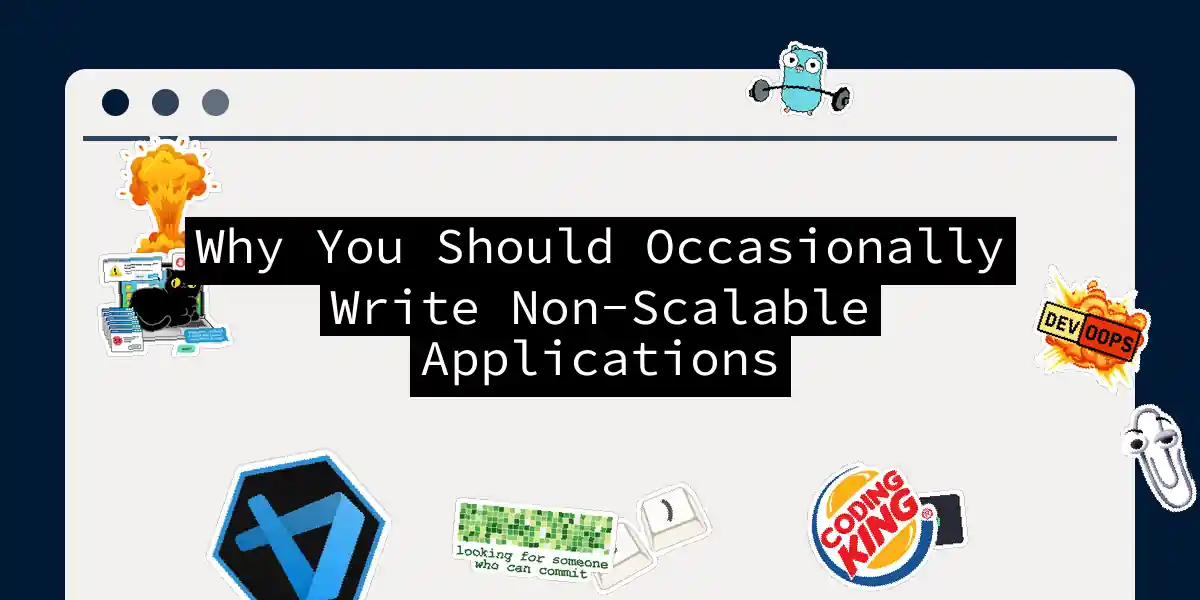Breaking the Scalability Obsession
Let’s start with heresy: sometimes writing deliberately non-scalable code is the professional choice. I know, I know – it feels like suggesting a chef should occasionally undercook chicken. But hear me out before you grab the pitchforks. That prototype needed yesterday? That internal tool used by three people? That experimental feature with a 5% adoption chance? Sacrificing scalability here isn’t laziness – it’s strategic triage. Think of scalability debt like financial debt: sometimes taking a small, intentional loan lets you seize an opportunity. The key is knowing when to pay it back… or knowing the loan will self-destruct before maturity. Remember Dave’s Law: “A program that must be changed is harder to change than one that never worked.”
When Non-Scalable Wins: The Sweet Spots
Proof-of-Concept Prototypes
# Database? Who needs databases!
results = {}
for file in glob.glob("*.csv"):
with open(file) as f:
results[file] = process(f.read()) # Load entire file? YOLO!
Here’s the brutal truth: if I’d built a Kafka pipeline for that PoC, the business would’ve moved on before I finished. Sometimes you need to answer “Is this possible?” before “Can it handle 10k RPS?” Tactical Tools
# Internal deployment script for team of 3
for server in $(cat servers.txt); do
scp build.zip $server:/tmp && ssh $server "unzip /tmp/build.zip"
done
Adding Kubernetes orchestration here would be like using a flamethrower to light a birthday candle. When your user count fits in a minivan, optimize for readability, not horizontal scaling. Experimental Features
// Temporary analytics hack
window.tempTracker = (event) => {
const blob = new Blob([JSON.stringify(event)], ...);
navigator.sendBeacon("/analytics-dump", blob); // Just firehose it!
};
When testing whether users even want a feature, collecting messy data fast beats elegant collection of nothing.
The Art of Intentional Technical Debt
Writing non-scalable code responsibly requires discipline:
- Fence the Debt
Wrap non-scalable components in modules with clear interfaces. Pretend it’s radioactive – contain it! - Document the Grenade Pin
Comments like this save careers:// NON-SCALABLE: Global cache for <1k items. // BREAKS at ~1500 users. See ticket #PAYME-42 var userCache = make(map[string]User) - Schedule the Bomb Disposal
Link non-scalable code to a specific trigger:- [ ] Refactor inventory sync when: * Daily active users > 500 OR * Support tickets about sync > 3/week - Build the Scaffolding First
Even in quick hacks, leave extension points:def process_data(data): # Currently uses simple loop # Replace with Ray when needed return [transform(item) for item in data]
When Non-Scalable Becomes Unforgivable
| Scenario | Non-Scalable Approach | Acceptable? |
|---|---|---|
| Core payment processing | Single-threaded processing | ❌ |
| User profile service | Global in-memory cache | ❌ |
| Marketing A/B test dashboard | CSV exports + local scripts | ✅ |
| Christmas promo microsite | Monolithic PHP script | ✅ |
The litmus test: Will scaling needs likely emerge before we can refactor? If yes, you’re not being pragmatic – you’re planting time bombs.
The Psychology of Strategic Scaling
This workflow acknowledges reality: 60% of ideas fail. Spending three weeks building scalable infrastructure for a feature killed after launch isn’t engineering rigor – it’s professional wastefulness.
The Payoff: Controlled Burn Development
Last quarter, our team shipped 4x more experiments by embracing tactical non-scalability. The secret? We had a technical debt SWAT team that followed behind successful prototypes like literary editors cleaning up a first draft. As my teammate Sarah says: “Scalability is like punctuation – essential for published works, optional for brainstorming notes.” Now if you’ll excuse me, I need to go violently refactor that CSV processor from last year… before it meets real users.
